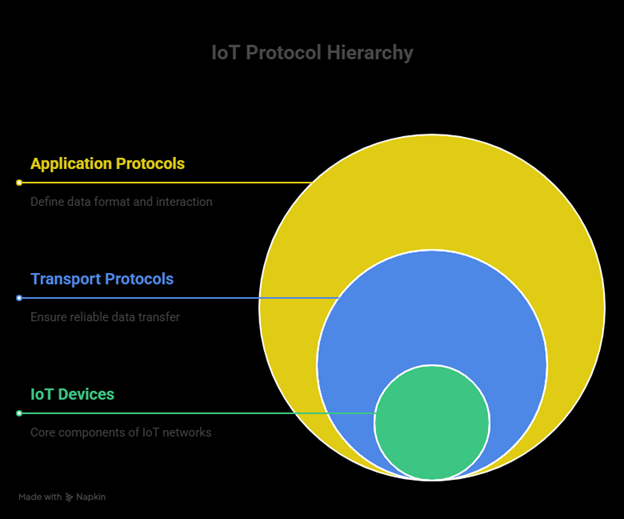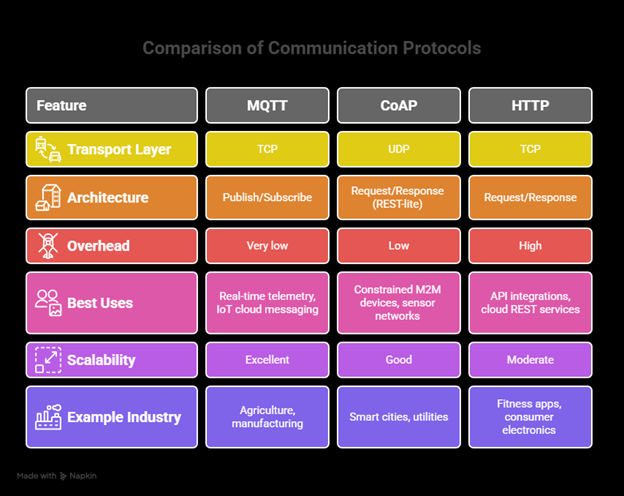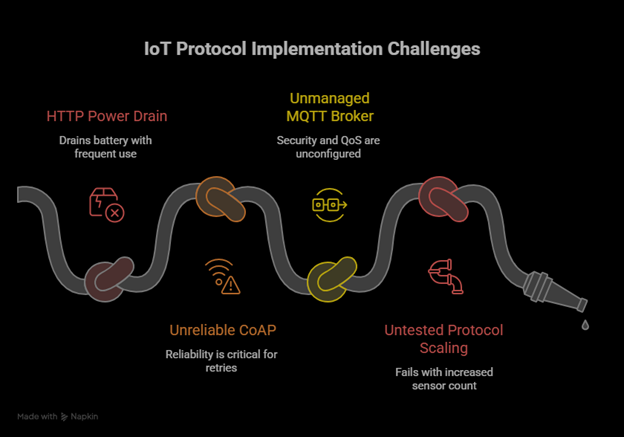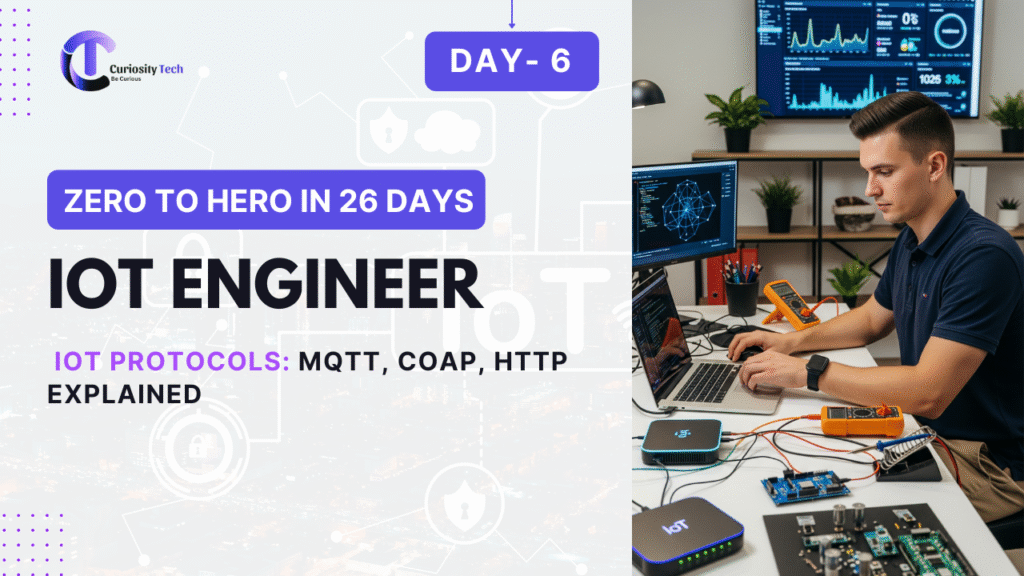Scene:
Two IoT engineers, Ravi (20 years in embedded systems, pragmatic and detail-oriented) and Ananya (10 years in networking and cloud architecture, futuristic thinker), are sitting at CuriosityTech.in’s IoT Lab in Nagpur, guiding a group of young engineers. They’re discussing what transport and application-layer protocols make IoT devices “talk” effectively.

Ravi: Defining Protocols Without the Jargon
“Look, when we talk about IoT protocols, we’re essentially talking about languages. Devices need to ‘speak’ a common language to communicate with gateways, servers, or other devices. The three most practical ones you’re going to encounter — and should master quickly — are MQTT, CoAP, and HTTP.”
Ananya: Why Protocols Matter in IoT
“And unlike traditional IT networking, IoT has unique challenges: low power consumption, small data packets, gate-limited bandwidth, and millions of devices that need to talk at once. That’s why engineers must choose the right protocol — you don’t use a heavy transport when all you need is lightweight communication for sensors.”
Deep Dive into Each Protocol
MQTT (Message Queuing Telemetry Transport)
Ananya:
“MQTT is my favorite — lightweight, publish/subscribe based. Devices don’t talk directly to each other. Instead, they push messages to a broker, and whoever wants the data subscribes. It’s like a bulletin board where anyone can post and anyone can read.”
Ravi adds:
- Ideal for low-power, low-bandwidth environments.
- Originally designed for oil pipeline sensors, now used everywhere.
- Needs a broker (like Mosquitto, EMQX, HiveMQ).
Example:
- A soil sensor publishes moisture data → MQTT broker.
- Cloud dashboard subscribes and displays trends to farmers.
CoAP (Constrained Application Protocol)
Ravi explains:
“CoAP is designed for constrained devices using a REST-like model. Think of it as ‘HTTP-light’ for IoT. It works on UDP instead of TCP, so it’s faster and more efficient on lossy networks, but less reliable unless combined with retries.”
Ananya adds:
- Great for resource-constrained devices that can’t handle TCP overhead.
- Works in M2M (machine-to-machine) environments.
- Closely resembles HTTP verbs (GET, POST, PUT, DELETE).
Example:
- Smart streetlight nodes using CoAP send ON/OFF commands across mesh networks.
- City’s management server controls thousands of lampposts without heavy HTTP.
HTTP (HyperText Transfer Protocol)
Ananya:
“HTTP is the grand old protocol powering the web. In IoT, it’s still used, especially when you need compatibility with existing web services, APIs, and dashboards. But for constrained devices, it’s often too heavy.”
Ravi cautions:
- HTTP runs over TCP, meaning more overhead.
- Fine for firmware updates (OTA), cloud REST APIs, data pull/push from large services.
- Not ideal for battery-powered field sensors.
Example:
- Fitness trackers uploading daily summaries via HTTP to a health app.
- Industrial devices fetching firmware patches via HTTP downloads.
Debate Point: Which One Should IoT Engineers Master First?
Ravi:
“I always tell students: start with HTTP. It’s widely familiar, almost every beginner knows how to do a REST API. Once comfortable, shift to MQTT for real IoT scaling.”
Ananya:
“I disagree — beginners should go straight into MQTT. HTTP makes engineers lazy; they don’t learn resource optimization. With MQTT, they understand how constrained networks actually work. CoAP is advanced; learn last, when you’re tackling large-scale constrained devices.”
Moderator at CuriosityTech Workshop:
“So perhaps the roadmap is: Start → HTTP basics, Move → MQTT mastery, Expand → CoAP when industrial integration is needed.”
Comparative Table: IoT Protocols
| Feature | MQTT | CoAP | HTTP |
| Transport layer | TCP | UDP | TCP |
| Architecture | Publish/Subscribe | Request/Response (REST-lite) | Request/Response |
| Overhead | Very low | Low | High |
| Best Uses | Real-time telemetry, IoT cloud messaging | Constrained M2M devices, sensor networks | API integrations, cloud REST services |
| Scalability | Excellent | Good | Moderate |
| Example Industry | Agriculture, manufacturing | Smart cities, utilities | Fitness apps, consumer electronics |

Real-World Industrial Applications
- MQTT in Industrial IoT: Predictive maintenance systems in factories (machines continuously publish vibration data).
- CoAP in Smart Grids: Utility meters reporting usage over large mesh.
- HTTP in Healthcare IoT: Patient management dashboards syncing wearable data with EMRs.
During live CuriosityTech Nagpur labs, students tested MQTT by building a small “IoT Temperature Publisher” project using ESP32 + Mosquitto broker installed on Raspberry Pi. This brought home how publish/subscribe is central to scalability.
Conceptual Infographic Description
Visualize three “roads” for messages:
- MQTT Lane: Lightweight motorcycles zipping efficiently between broker stations.
- CoAP Lane: Bicycles on a narrow road — fast, resource-efficient, but fragile on rough terrain.
- HTTP Highway: Trucks carrying heavy loads, reliable but not suitable for every small lane.
This analogy often helps students in IoT networking workshops grasp the strengths and weaknesses quickly.
Beginner Pitfalls
- Sending raw sensor data via HTTP every second (battery killer!).
- Using CoAP where reliability is critical (without retries).
- Forgetting broker management in MQTT (security, QoS not configured).
- Not testing protocols under scaling conditions — what works for 5 sensors may fail at 5,000.

Conclusion
Choosing the right IoT protocol is about balance. HTTP offers compatibility, MQTT offers efficiency and scalability, and CoAP delivers lightweight communication in constrained scenarios. True IoT engineers master all three because real-world projects demand flexibility.
Learning environments like CuriosityTech.in Nagpur train students by using side-by-side protocol labs — for instance, connecting the same ESP32 sensor via HTTP, then MQTT, then CoAP, to see performance differences firsthand. By 2025, employers expect IoT engineers not to ask “HTTP vs MQTT?” but to say “This project needs MQTT, and here’s why.”


